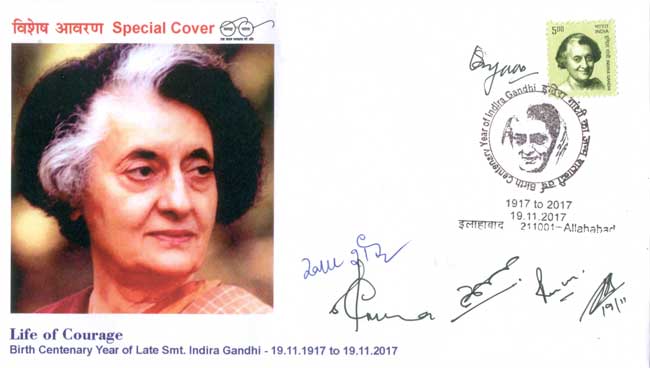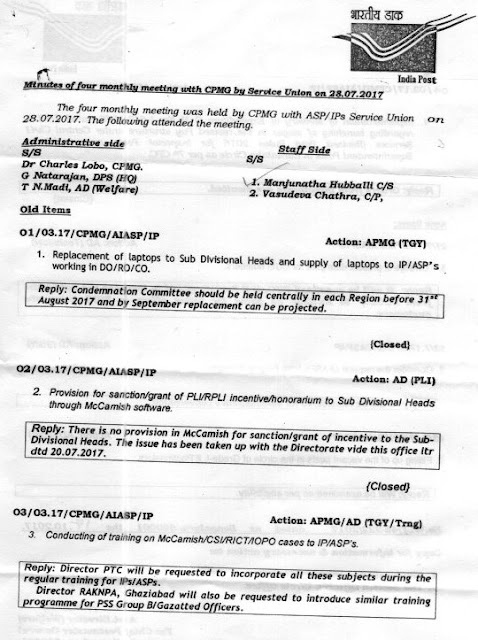This blog is meant for the use by members of the Association for sharing news and views. Sri C.G.Kamble. (Circle President), Assistant Supdt. Post (HQ), Bagalkot Dn, Bagalkot-587101, Sri Sreenivas.M.J.(Circle Secretary), Assistant Supdt.Post (I.R.), O/o PMG, South Karnataka Region, Bengaluru-560001. Sri Vasanth, [Circle Treasurer] Assistant Supdt.Post (Vigilance), O/o PMG, South Karnataka Region, Bengaluru-560001. Send your views and suggestions to : ipaspkarnataka@gmail.com

Thursday, November 30, 2017
CHQ News: DPC for promotion to the PS Gr. B cadre for the year 2017-18
GS informed that, Today, discussed the issue with concerned officers at Directorate about holding of DPC. I am told that the list of the officers who are in the zone of consideration will be circulated very soon.
CCS (Classification, Control and Appeal) Rules, 1965- Classification of Posts
To view, please CLICK HERE.
Sl.No.
|
Description
of Posts |
Classification
of posts |
(1)
|
(1)
|
(3)
|
1
|
A Central Civil Post carrying the pay in the Pay Matrix at the Level from 10 to 18.
|
Group A
|
2
|
A Central Civil Post carrying the pay in the Pay Matrix at the Level from 6 to 9.
|
Group B
|
3
|
A Central Civil Post carrying the pay in the Pay Matrix at the Level from 1 to 5.
|
Group C
|
Wednesday, November 22, 2017
Instructions to be followed during issue of ATM Card

CIF level Checks
• Below issues at CIF will lead to non activation of cards:
Ø Last name column in CIF should not exceed 35 Characters
Ø Last Name column in CIF should not contain special and numeric characters
Ø Address line at CIF level should not exceed 35 characters and special character s like (<, >, ?)
Ø Name at account level should be as mentioned in the CIF
• Wrong issuance of Instant Cards
• SOLs are dispatching Instant ATM card duly linked to the account by post which may lead to mis-appropriation as both PIN and card will be available in the same envelope.
• SOLs are placing New card request after hot listing /personalized card request / Replacement /closure which will lead to non-activation of new card request and that kit/card cannot be used further and reflects in inactive cards.
• Issuing of new kit for the CIF which was already issued with another Kit number.
• WRONG ATM PIN REQUEST
• SOLs are placing ATM PIN request multiple times with out waiting for the receipt of PIN from National ATM Unit.
• Many SOLs are just sending mails for duplicate PIN with out placing request in CCMM menu
• Closure of ATM Card
• SOLs are closing the accounts with out closing the ATM cards. Such cards will be in active status and cannot be closed in later stage.
• Few SOLs have closed the existing cards and again placed new card request, which will not get activated.
• CIF merger of ATM issued accounts
• Once the ATM cards are issued to any of the SB accounts, such CIFs should not be merged to any other CIF.
• After merging the CIF, one more card is being issued to the new CIF of the same account. In such a case both the cards will be active and lead to fraudulent transactions.
• Eligibility criteria Issuing of ATM cards
• Cards should be issued only to SB General and Pension accounts.
• In case of Joint, should be issued only to Joint “B”
• ATM cards should not be issued to Minor, Illiterate, Joint “A”, SBBAS, BO accounts and Lunatic accounts.
• Only one card per customer should be issued. In case of multiple accounts, linking should be done after activation of card with the primary account.
Procedure for issue of duplicate ATM cards in case of missing of the original one :
Under CCMM menu use Modify function and enter CIF id and in the next screen select Action as "hotlist and replace or Replacement in case already hotlisted. Then select Card type as Personalized and again click on Instant. Then enter the Instant kit number which is to be issued to the customer and card will get activated after 24 hours.
Banking Facility For Senior Citizen And Differently Abled Persons – RBI
RESERVE BANK OF INDIA
RBI/2017-18/89
DBR.No.Leg.BC.96/09.07.005/2017-18
DBR.No.Leg.BC.96/09.07.005/2017-18
November 9, 2017
All Scheduled Commercial Banks (including RRBs)
All Small Finance Banks and Payments Banks
Dear Sir/ Madam,
Statement on Developmental and Regulatory Policies – October 4, 2017 – Banking Facility for Senior Citizens and Differently abled Persons.
Please refer to Paragraph 8 of Statement on Developmental and Regulatory Policies, released by Reserve Bank of India on October 4, 2017 as part of Fourth Bi-monthly Monetary Policy Statement 2017-18, a copy of which is enclosed. It has been observed that there are occasions when banks discourage or turn away senior citizens and differently abled persons from availing banking facilities in branches. Notwithstanding the need to push digital transactions and use of ATMs, it is imperative to be sensitive to the requirements of senior citizens and differently abled persons.
2. In view of the above, banks are required to put in place appropriate mechanism with the following specific provisions for meeting the needs of such customers so that they are able to avail of the bank’s services without difficulty.
(a) Dedicated Counters/Preference to Senior Citizens, Differently abled persons
Banks are advised to provide a clearly identifiable dedicated counter or a counter which provides priority to senior citizens and people who are differently abled including visually impaired persons.
(b) Ease of submitting Life Certificate
As per extant guidelines issued by Department of Government and Bank Accounts, in addition to the facility of Digital Life Certificate under “Jeevan Praman” Scheme (refer circular DGBA.GAD.H-2529/45.01.001/2014-15 dated December 9, 2014), pensioners can submit physical Life Certificate form at any branch of the pension paying bank. However, it is observed that often the same is not updated promptly by the receiving branch in the Core Banking Solution (CBS) system of the bank, resulting in avoidable hardship to the pensioners. It is, therefore, advised that banks shall ensure that when a Life Certificate is submitted in any branch, including a non-home branch, of the pension paying bank, the same is updated/ uploaded promptly in CBS by the receiving branch itself, to avoid any delay in credit of pension.
(c) Cheque Book Facility
(i) Banks shall issue cheque books to customers, whenever a request is received, through a requisition slip which is part of the cheque book issued earlier.
(ii) Banks are advised to provide minimum 25 cheque leaves every year, if requested, in savings bank account, free of charge.
(iii) Banks shall not insist on physical presence of any customer including senior citizens and differently abled persons for getting cheque books.
(iv) Banks may also issue cheque books, on requisition, by any other mode as per bank’s laid down policy.
It is further clarified that providing such facility in BSBDA will not render the account to be classified as non-BSBDA (c.f. Bank’s response to query number 14 and 24 of our circular “DBOD.No. Leg. BC.52/09.07.005/2013-14 dated September 11, 2013 on Financial Inclusion – Access to Banking Services – BSBDA – FAQs”).
(d) Automatic conversion of status of accounts
Presently, in some banks, even fully KYC – compliant accounts are not automatically converted into ‘Senior Citizen Accounts’ on the basis of date of birth maintained in the bank’s records. Banks are advised that a fully KYC compliant account should automatically be converted into a ‘Senior Citizen Account’ based on the date of birth available in bank’s records.
(e) Additional Facilities to visually impaired customers
Banks are advised that the facilities provided to sick/old/incapacitated persons vide Paragraph 9 of our Master Circular DBR.No.Leg.BC.21/09.07.006/2015-16 dated July 1, 2015 on Customer Service in Banks (regarding operations of accounts through identification of thumb/toe impression/mark by two independent witnesses and authorising a person who would withdraw the amount on behalf of such customers) shall also be extended to the visually impaired customers.
(f) Ease of filing Form 15G/H
Banks are advised to provide senior citizens and differently abled persons Form 15G/H once in a year (preferably in April) to enable them to submit the same, where applicable, within the stipulated time.
(g) Door Step Banking
We have issued instructions on Doorstep Banking vide circular DBOD.No.BL.BC.59/22.01.010/2006-2007 dated February 21, 2007 under Section 23 of Banking Regulation Act, 1949. However, in view of the difficulties faced by senior citizens of more than 70 years of age and differently abled or infirm persons (having medically certified chronic illness or disability) including those who are visually impaired, banks are advised to make concerted effort to provide basic banking facilities, such as pick up of cash and instruments against receipt, delivery of cash against withdrawal from account, delivery of demand drafts, submission of Know Your Customer (KYC) documents and Life certificate at the premises/ residence of such customers.
3. Banks are advised to implement these instructions by December 31, 2017 in letter and spirit and give due publicity in their bank branches and website.
Yours faithfully
(Saurav Sinha)
Chief General Manager
Statement on Developmental and Regulatory Policies, Reserve Bank of India issued by the Governor on October 4, 2017
8. Banking Facility for Senior Citizens and Differently abled Persons It has been reported that banks are discouraging or turning away senior citizens and differently abled persons from availing banking facilities in branches. Notwithstanding the need to push digital transactions and use of ATMs, it is imperative to be sensitive to the requirements of senior citizens and differently abled persons. It has been decided to instruct banks to put in place explicit mechanisms for meeting the needs of such persons so that they do not feel marginalised. Ombudsmen will also be advised to pay heed to complaints in this context. Necessary instructions in this regard will be issued by end-October 2017
Source:www.rbi.org.in
Special Cover on Birth Centenary of Smt. Indira Gandhi – 19th November 2017.
Indira Gandhi (b. 19 November 1917 - d. 31 October 1984) was an Indian politician and the only female Prime Minister of the country. Born in the famous Nehru family, she was perhaps destined for an illustrious political career. She served as Prime Minister from 1966 to 1977 and from 1980 until her assassination in 1984. As Prime Minister, Indira was known for centralisation of power and political ruthlessness. Her political career was littered with controversies as well as allegations of highhandedness, corruption and nepotism. She clamped a state of emergency in India from 1975 to 1977. She was also criticized for carrying out the Operation Blue-Star in Punjab that eventually scripted her assassination on 31 October 1984. Indira Gandhi left behind her a lasting political legacy and her family became one of the most prominent political names in India.
On the occasion of the Birth Centenary of Late Smt. Indira Gandhi, a Special Cover was released at Allahabad on 19th November 2017 by Mrs. Roopa Shankar, Mrs. Samina Naqvi, Mr. Narsingh, SSRM of Post Office and Mr. Pramod Kr. Bansal, the President of Prayag Philatelic Society at the function held at Head Post Office, Allahabad. (Special Cover approval no. UP/17/2017).


Thursday, November 2, 2017
Maximum age of joining National Pension System (NPS) increased from the existing 60 years to 65 years under NPS- Private Sector
01-November-2017 17:08 IST
Maximum age of joining National Pension System (NPS) increased from the existing 60 years to 65 years under NPS- Private Sector.
In continuance of the several initiatives under taken by Pension Fund Regulatory and Development Authority (PFRDA) during the last few years to increase the pension coverage in the country, PFRDA has now increased the maximum age of joining under NPS-Private Sector (i.e. All Citizen and Corporate Model) from the existing 60 years to 65 years of age.
Now, any Indian Citizen, resident or non-resident, between the age of 60- 65 years, can also join NPS and continue up to the age of 70 years in NPS. With this increase of joining age, the subscribers who are willing to join NPS at the later stage of life will be able to avail the benefits of NPS.
NPS provides a very robust platform to the subscriber to save for his/her old age income security. Due to the better healthcare facilities and increased fitness, along with the opportunities and avenues available in the private sector as well as in the capacity of self-employment, more and more people in their late 50s or 60s are now living an active life allowing them to be employed productively.
The subscriber joining NPS beyond the age of 60 years will have the same choice of the Pension Fund as well as the investment choice as is available under the NPS for subscribers joining NPS before the age of 60 years.
Subscriber joining NPS after the age of 60 years will have an option of normal exit from NPS after completion of 3 years in NPS. In this case, the subscriber will be required to utilize at least 40% of the corpus for purchase of annuity and the remaining amount can be withdrawn in lump-sum.
In case of such subscriber willing to exit from NPS before completion of 3 years in the NPS, he/she will be allowed to do so, but in such case, the subscriber will have to utilize at-least 80% of the corpus for purchase of annuity and the remaining can be withdrawn in lumpsum.
In case of unfortunate death of the subscriber during his stay in NPS, the entire corpus will be paid to the nominee of the subscriber.
The increase in joining age will provide the options to the subscribers who are at the fag-end of the employment and expecting lump-sum amount at the time of retirement, but willing to defer their retirement planning for future, to open the NPS account and contribute the lump-sum corpus to NPS for better fund management by Professional Fund Manager to fetch better returns and plan for the regular income after some time. The Annuity rates available in the older age fetch better annuities than that at the age of 60 or less age.
This initiative will allow a larger segment of the society particularly senior citizens to reap the benefits of NPS and plan for their regular income.
WhatsApp adds new ‘Delete for Everyone’ feature: Here’s how to use this

WhatsApp 'Delete for Everyone' feature that allows users to delete sent messages is now rolling out to all users, a week after it trickled out to select users of the app. The feature lets people call back messages sent on individual chats as well as WhatsApp groups, and is available across different platforms, such as Android, iPhone and Windows Phone. One of the biggest use cases of the Delete for Everyone feature can be when you send a message to the wrong chat or if the message sent contains a mistake. It is the latest feature added to WhatsApp in a long list of features introduced this year, and is biggest change to the chat app since blue ticks.
The Facebook-owned service confirms messages that have been successfully deleted for everyone will be replaced with "This message was deleted" in your recipients' chats. Similarly, if you see "This message was deleted" in a chat, it means that the sender deleted their message for everyone.
How to get WhatsApp 'Delete for Everyone' feature, and how it works
· Make sure you the latest version of WhatsApp is downloaded on your phone. The recipient must also have the latest version installed for the Delete for Everyone feature to work.
· Select the message(s) you want to delete
· Tap the delete/ trash icon on the screen
· Now the dialogue box will show the new option Delete for Everyone
Once you hit the Delete for Everyone dialogue box, the sent message will be replaced with "You deleted this message". Also, remember that the feature will not work if the other person is not on the latest version of WhatsApp; in this case, recipients may see the message before it's deleted or if deletion was not successful.
WhatsApp says that the feature will be applicable only if the user is quick enough. The company explains that users can only delete messages for everyone for up to seven minutes after sending. This means that once seven minutes have passed, there is no way to delete messages for everyone.
Apart from 'Delete for Everyone', WhatsApp has renamed the regular delete option, calling it Delete for Me. This, as before, allows users to delete the message they've sent or received from the device. However, this will have no effect on the recipients' chats. This feature will not change anything on the recipients end and they can continue seeing the messages in their chat screen.
To delete messages for yourself, users can head to the chat containing the message they wish to delete and tap and hold the message to delete multiple messages at once. In this case, users will have to use tap Delete (the trash icon) at the top of the screen, and then select Delete for Me.
Wednesday, November 1, 2017
Subscribe to:
Comments (Atom)














